Spring 2013: Expanded Cinema at the Kimura Gallery, Feb. 18-March 20
by Michelle Saport |
Anthony McCall is an internationally significant filmmaker and, along with the other four avant-garde filmmakers, we have a first-rate and diverse body of work for UAA and the community at large. This is an exhibition you don't want to miss! Click through for more information on the featured artists and teaser photos.
This exhibition was conceived in two parts. During the first week of this exhibition, the gallery will display the work of Anthony McCall, one of today's innovative artists using light projections as his medium. In the 1970s, he developed his concept of filmless projections that transformed film into an interactive, installation-based experience. The second phase of this exhibition consists of screening the films of four avant-garde filmmakers: Tony Balko, Martha Colburn, Brent Coughenour and Michael Walsh. The works of these filmmakers are very different and provide the spectator with a wide range of unique cinematic experiences and visions.
Exhibit schedule:
Feb. 18-22, Anthony McCall
Screening of Anthony McCall's "Line Describing a Cone," 1973 (30 minutes)
Monday, Feb. 18, 6:30 p.m.
Kimura Gallery (Fine Arts Building, Second Floor)Anthony McCall's "Line Describing a Cone 2.0 Digital Version," 2011 (30 min.)
Tuesday-Friday, Feb. 19-22, 11 a.m.-3 p.m.
Kimura Gallery (Fine Arts Building, Second Floor)
Feb. 25-March 20, Four Filmmakers
Opening for Four Filmmakers
Monday, Feb. 25, 5:30-7 p.m.
Kimura Gallery (Fine Arts Building, Second Floor)Lecture by Michael Walsh, featured filmmaker
Monday, Feb. 25, 7:30 p.m.
Fine Arts Building, Room 117Feb. 25-March 20, 10 a.m.-5 p.m.
Screenings for the following films: Tony Balko, "3 Men and A Baby Ghost;" Martha Colburn, "Triumph of the Wild;" Brent Coughenour, "work in progress;" Michael Walsh, "Braking Breath."
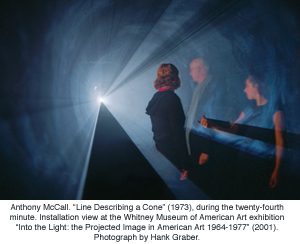 Anthony McCall
Anthony McCall
For the past 40 years, Anthony McCall's corpus of work has evolved into an interdisciplinary
direction that overlaps and combines various media including sculpture, film and drawing.
His historical significance is secure in the annals of cinema history. It was in 1973
that he developed his concept of filmless projections with his project, "Line Describing
a Cone." In a dark room, a volumetric form of projected light is gradually transformed
into a three-dimensional cone. The darkened room is filled with mist produced by a
hazer allowing for the cone to materialize. The duration of the work is 30 minutes
and begins with a white point projected onto the wall. The point gradually arcs around
creating a circular configuration that ultimately creates a cone of light. Once the
cone is created one can interact with it by peering into it as well as disrupting
the projection with one's body. As a spectator, one literally plays with the cone
of light. The experience is ethereal, consisting of an artificially produced ray of
light reminiscent of light streaming through a forest of tall pines horizontally disposed.
Over the years, he has advanced the complexity of his projects. His most recent proposed project, "Column," for the 2012 London Olympics would have been an unforgettable experience. It was postponed and he is currently engaged in resolving the technical issues to realize his project. He perceives the Column as "a spinning column of cloud that will rise from the surface of East Float, Merseyside." From a formal perspective, the Column is "a vertical line drawn in the sky: seen closer up, it is a hollow tube of spinning cloud with a diameter of about 20 metres." The Column would be protean in nature constantly fluctuating as it moved through the cloud formations providing the needed mist to produce the illusion of solid light. This project is akin to his earlier work of the 1970s. However, "Column" is opposite his earlier indoor projections, which were done in a controlled misted space. McCall notes that the Column is "a shaped column of mist that gains its visibility from being projected through the ambient light." This type of work with its meteorological character is technologically based and is intriguing to consider in relation to concepts of the sublime and beauty as aesthetic categories (categories that are still being contested today). Can technology be useful in capturing a sense of the artistic sublime as paradoxical as it might appear? Technology has certainly impacted the development of land art since the 1990s in ways that were not conceived of during the heyday of land art in the '70s. "Column" would be temporarily linked to the natural world by means of light and the random effects of the weather--a kind of ephemeral sublime.
McCall's work has been exhibited at some of the most prestigious museums and galleries in New York City, Vienna, Zurich, Berlin, Washington, D.C., Paris, London, Milan, Stockholm, Frankfurt, Barcelona and Wellington. He is the subject of numerous books. Two of the most recent and insightful are "Anthony McCall: Five Minutes of Pure Sculpture by Christina Weiss (2012) and "Anthony McCall: The Solid Light Films and Related Works" by Christopher Eamon, Brandon W. Joseph and Jonathan Walley (2005).
A good place on the web to find more information on McCall is his page on the Sean Kelly Gallery website. There you'll find selected work, press, news, exhibitions and more. You can also access a recent review of McCall's work by Tyler Coburn for Art News here.
Four Filmmakers: Tony Balko, Martha Colburn, Brent Coughenour and Michael Walsh
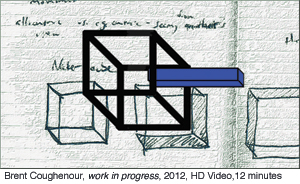 Brent Coughenour
Brent Coughenour
Brent Coughenour is a media artist originally from Detroit, Mich. who now resides
in California. One of the major leitmotifs in his work focuses on "narrative cinematic
language" that transcends traditional notions of drama and plot-based films. The newer
works involve computer programming allowing him to manipulate audio and video for
performance-based projects. The work being screened in this exhibition is titled "work
in progress" (2011). His commentary about this work reflects the open-endedness of
the project: "Something here to describe, in roundabout terms, not what it means,
but rather, what it does." He has produced an impressive body of work over the years
such as the three-part trilogy, "Mysterium Cosmographicum" (2011), "I Pity the Fool"
(2007), "Night Flight" (2006), "Ash Wednesday" (2004) and Untitled (2001). Live performances
include "Live Performance for Video, Sine Waves and Samples" (2009) and "The Indomitable
Human Spirit" (2008).
He has presented his work at a variety of venues throughout North America, Europe and Asia, including the International Film Festival Rotterdam, Media City Film and Video Festival, Antimatter Film Festival, Onion City Film and Video Festival, Experimental Film and Video Festival in Seoul, and Ann Arbor Film Festival. His work is distributed by Video Data Bank. For more information, read the insightful essay by the Canadian filmmaker and critic Mike Hoolboom "My Big Fat Avant-Garde Movie: Notes on Brent Coughenour's Mysterium Cosmographicum" (from the catalog for the "Fall 2011 Mary L. Nohl Fund Fellowship for Individual Artists" exhibition). To access Hoolbom's essay and see samples of the artist's work, visit brentcoughneour.com.
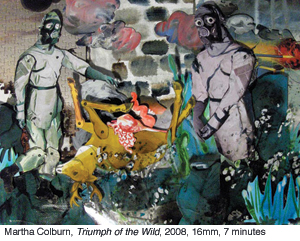 Martha Colburn
Martha Colburn
Martha Colburn's animated film "Triumph of the Wild" (2008) was selected for presentation
in the gallery. The piece was originally curated by Creative Time for the Times Square
video screen. It is a creative tour-de-force weaving together a panoramic tapestry
spanning the American Revolution through the Vietnam and Middle East wars. The film
is a chronicle of America that looks at the "hunting impulse as a primary force."
She asks us to consider why the human species is "impotent in the face of nature?
Why do we live in a world that perpetuates destruction and obsessively accumulate
weapons?"
She is a filmmaker and multimedia artist who was born in Pennsylvania and spends her time in Holland and New York City. A 1994 B.F.A. graduate of the Maryland Institute College of Art in Baltimore, Md., Colburn also studied for two years, with the support of the Dutch Ministry of Education, Culture and Science, at Rijksakademie Van Beeldende Kunsten in Amsterdam where she received an M.F.A. equivalent in 2002.
In 1994, she produced her first hand-manipulated found footage films: "Acrophobic Babies," "First Film in X-Tro" and "Feature Presentation." At this time, she began to explore a variety of different approaches in her live performances including 16mm and Super 8 projectors that incorporated mirrors, colored gels, strobes, hand-painted screens and the live accompaniment of musicians. She performed with her friends in various musical groups at this time as well as producing videos for them. The remainder of the decade involved networking, presenting, touring and exposing a public to her films in Europe and the U.S.
In the early aughts, while living in the Netherlands, she continued to produce work involving multimedia art installations, filmmaking and teaching. This was a transitional time in her development as a filmmaker, a sea change in which social and political issues became increasingly important in her work.
Her involvement with the Lower Manhattan Cultural Council art residency program in 2005 involved a revived interest in collaborating with musicians who provided the music for her presentations. The combination of live music, sound and film led to various performances at the Museum of Art & Design in NYC, The Knitting Factory, Rotterdam Film Festival, Sundance Film Festival and the San Francisco Museum of Modern Art. In 2009, Electric Literature commissioned her to create a film for a single sentence by the author Diana Wagman. These last few years, she's also created music videos for Serj Tankian, Deerhoof, Friendly Rich and They Might Be Giants.
She also provided animation for the feature film "The Devil and Daniel Johnson," which won the award for Best Documentary at the Sundance Film Festival. Colburn's highly topical "Cosmetic Emergency" was inducted into the 2005 Cannes Film Festival.
Visit the artist's website for a complete biography and sample work.
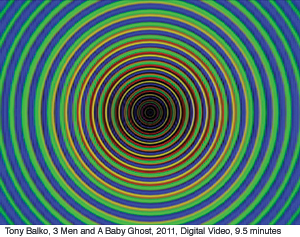 Tony Balko
Tony Balko
Balko's film "3 Men and a Baby" (2011) was selected to be screened for this exhibition.
The film launches an urban legend through The Rainbow, rupturing the barriers between
us, the movies and the spirit world. An ominous knock on Ted Danson's door leads to
a psychedelic trip through the astral plane. The truth behind myth is proven not to
matter, belief is affirmed and transcendence is unintelligible.
Tony Balko is an artist and educator from Smithton, Pa. He works primarily in the moving image, most often attempting to elicit the ecstatic in the viewing experience. He received his M.F.A. in film, video, animation and new genres from the University of Wisconsin-Milwaukee, where he also co-founded the monthly screening series "Light Stroke." His work has been shown throughout the U.S. and internationally in museums, galleries and micro-cinemas, including the Museum of Modern Art (New York), Milwaukee Art Museum, Institute of Contemporary Art (Boston), 21C Museum (Louisville), Jefferson Presents... (Pittsburgh), Green Lantern Gallery (Chicago), New Nothing Cinema (San Francisco) and Stereo Underground (Seoul, South Korea).
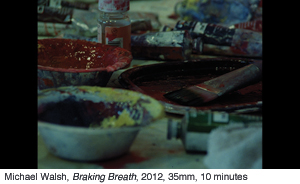 Michael Walsh
Michael Walsh
Michael Walsh has been making moving image art for more than 20 years. His work has
screened at the SFMOMA, Yerba Buena Center for the Arts, Nam June Paik Center in South
Korea and Anthology Film Archives in New York. He has an M.F.A. in film/video and
new genres from the Peck School of the Arts at UW-Milwaukee. Walsh works in digital
video and celluloid film as well as painting and installation. He challenges the constraints of
single channel work in expanded cinema, using found sculptural objects and projecting
digital moving images onto, into and around these objects. The film selected for this
exhibition is titled "Braking Breath" (2012). The film addresses how abstract truths
are revealed during a fragmented time away from home. It is a journey of self-discovery
through landscape and family.
As Walsh notes, "I think of myself as a practitioner of Expanded Cinema. My practice has embraced and evolved with the proliferation of digital platforms and a cross-pollination of multi-disciplinary techniques. My digital artwork is grounded in a love for celluloid film aesthetics, editing techniques and theory. I've made many 16mm, 35mm and digital single channel works as well as installations and paintings. In my single channel work, I've explored the beauty of the abstract as well as the appropriation of classic narrative cinema. In my cinematic installations I explore pastiche and parody using classic film noir and archival footage, juxtaposing kitsch objects and digital imagery. I cultivate a nostalgia for the narrative, implying the impossibility of a concise story in the contemporary context. Digital animation techniques and installation platforms are my essential tools to affirm fragmentation and reconfiguration of meaning, story and identity. Irony and humor challenge intellectual objectivity, promoting equal access for the viewer/participant from a broad and diverse range of experiences."
For more information on this Homer-based artist, visit walshinthecloud.com.
 "Spring 2013: Expanded Cinema at the Kimura Gallery, Feb. 18-March 20" is licensed under a Creative Commons Attribution-NonCommercial 4.0 International License.
"Spring 2013: Expanded Cinema at the Kimura Gallery, Feb. 18-March 20" is licensed under a Creative Commons Attribution-NonCommercial 4.0 International License.














